Project ALIAS - Collaborative WW1 Pension Records Project
- Home
- World War I Articles
- Project ALIAS - Collaborative WW1 Pension Records Project
Project ALIAS - the largest collaborative project in the history of The Western Front Association
This article pre-supposes that the reader is familiar with:-
- The Commonwealth War Graves Committee (CWGC) and its website
- Ancestry & Fold3 websites
- the Pension Record Cards (PRC), Ledgers and Medal Index Cards ( MIC) held in Fold3.
A lot has been written about the six million or so Ministry of Pensions records which were saved from destruction by The Western Front Association (WFA) in 2012. The records were digitised and, progressively, made available to members of The WFA via the Ancestry website. Project ALIAS grew out of this initiative and has been mentioned in several articles on The Western Front Association (WFA) website and in 'Bulletin'. What is it? Well, there is a plethora of articles, giving all the background, located here.
These articles talk at length about WHAT Project ALIAS is. What they don't tell you though is HOW more than 150 WFA members, from all parts of the world, have collaborated for 6 months in what is probably the largest project of its kind undertaken by The WFA since it was founded. We thought it might be of interest to the wider membership to explain, in a little more detail, how the project was delivered and the next steps.
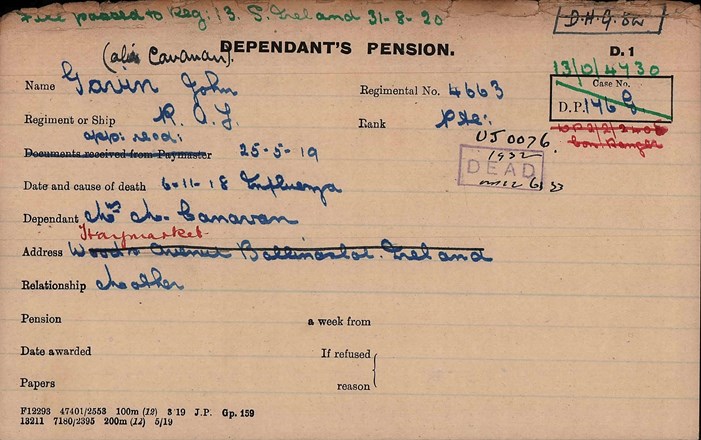
Going through the records in Fold3, it soon became apparent that many men attested and served under other names during World War One. Many of the cards show both the man's true family name and the alias name that he served under. The card that first set minds thinking about a project was the one above, when it was realised that a search for the name 'Cavanan' would fail to find the card. The vision for the project was to make sure that all such cards were indexed with both names so that all of a man's cards would be found by family or researchers, regardless of which name they searched on. Thus was born 'Project ALIAS'. It was realised from the outset that it would rely heavily upon help from the membership of The WFA. Appeals were put out to the members asking for volunteers to help with what would undoubtedly become a huge manual undertaking.
Rather than try and 'eat the elephant' all in one go, it was decided to try and break it into bite-sized chunks or phases. The phases, which overlapped, were set up as follows:-
- Phase One - the 'quick wins' or the Aliases that we already knew about.
- Phase Two - the Aliases that we'd have to go looking for.
- Phase Three - Aliases coming in from other sources g. the membership and the public
Phase One
In January 2020, the first phase of Project ALIAS was kicked off. This took as its starting point, the alias names already known to the CWGC. As can be seen below, the CWGC records show the man's true family name and, if it was known that he served under a different name, that is shown too - in this case, Walter Vincent is shown to have served under the name Harper.
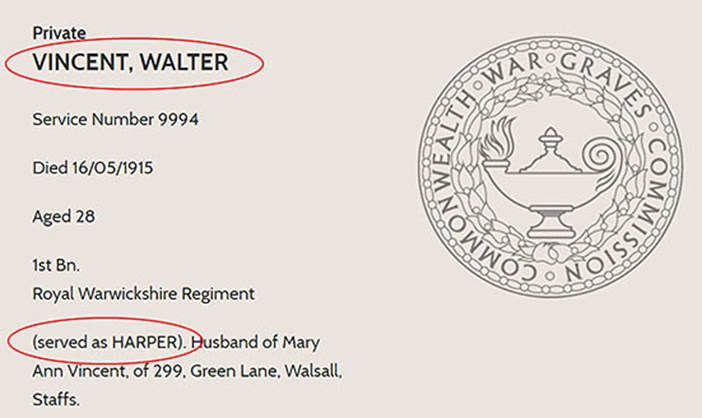
The CWGC supplied to The WFA a list of known aliases in the form of an Excel spreadsheet containing approximately 3,500 rows, each row representing an individual soldier who had served under an alias. It provided details about the soldier - his true family name, his alias name, his service number, regiment, rank, date of death, etc. The spreadsheet was subdivided into 71 'Books', each Book being a spreadsheet containing 50 such rows with additional columns to capture further information about each soldier.
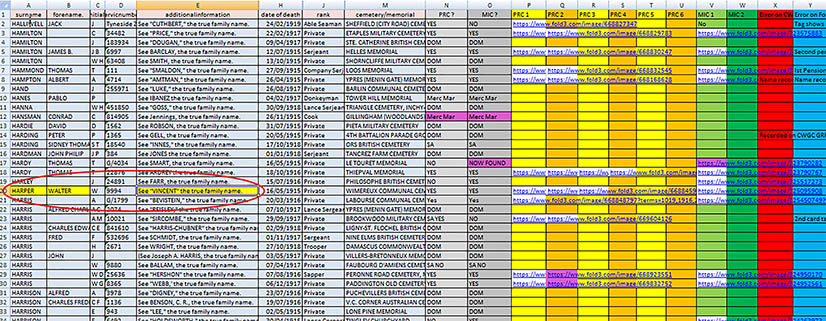
The example of a Book above shows the row for 'Walter Vincent alias Harper'. The columns in 'grey' are the details provided by the CWGC. The coloured columns are the extra data which was added during Project ALIAS Phase One. The Books were assigned to volunteers from The WFA whose job was to search Fold3, using both the soldier's true name and his alias name, and record all the PRCs, Ledgers and MICs for the man, in the coloured columns. Some men had no records (mostly Dominion troops and Mercantile Marines), most had two or three, a few had up to six or even more. Here is a story of one such man with six records and who actually used two alias names.
All of the Books were double-checked before being passed to a team of inputters. One soldier at a time, the soldier's cards were pulled up in Fold3 and corrections made to the index to ensure that both of his names were recorded. Below we see Vincent, Walter now has an alias of Harper, Walter.
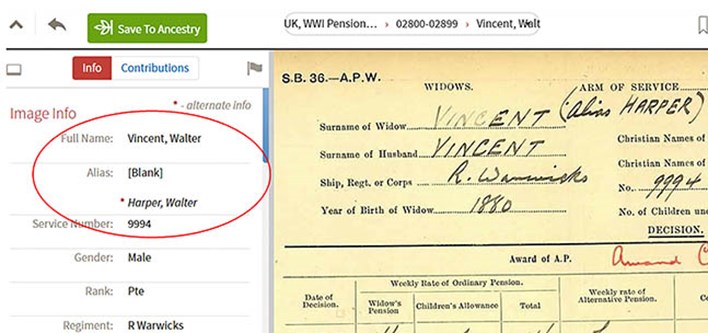
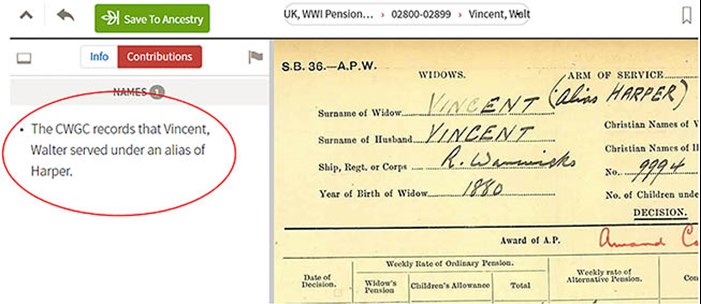
In addition, an 'annotation' was added to all of his cards to record the fact that the alias name had been notified by the CWGC. Any variations in the spelling of his name(s) was also captured in the Annotation. For these soldiers, a search on any of his names or variations of his names would return all the cards for the soldier. Phase One was completed on the 1st of June and a list of anomalies between the CWGC data and data held on the Fold3 cards was submitted to the CWGC for their consideration.
Phase Two
Whilst Phase One 'corrected' the alias records that were known by the CWGC, it was clear that the cards contained many more besides. Some cards are indexed only under the soldier's true name but make reference to his alias name; others are indexed only under his alias name but make reference to his true name. Some cards explicitly say 'Name A alias Name B'; others say 'Name A see (vide) Name B'. Some have a second name added or a name crossed out and replaced with another; others have what looks like the correction of the spelling of a name. It's not always possible to tell which are actually alias names and which are merely Ministry of Pensions corrections. A further complication is that some cards contain two or more names but they are actually brothers, or father and son, or some other relationship between soldiers who share the same next of kin or dependent person.
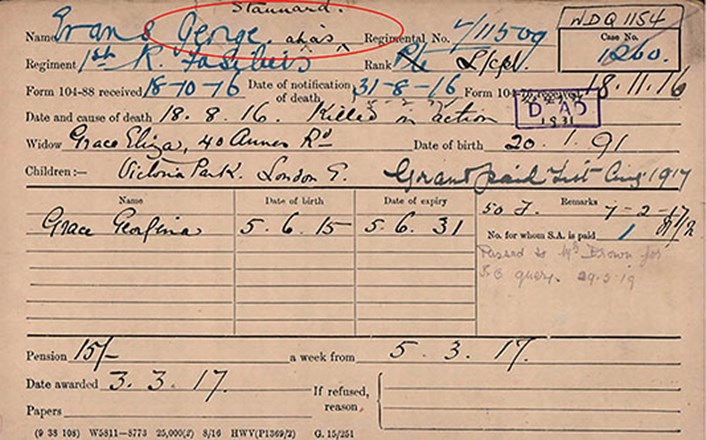
The approach taken for Phase Two was to go through all the cards, nearly one million of them, and look for any evidence of another name, be it an alias name, a correction to a name, or any of the other examples above. This phase could well have been called 'Project Other Name'.
Starting in February 2020, approximately 150 WFA volunteers, split into 8 teams, were engaged in this phase. Each volunteer was assigned a range of card drawers and searched through their drawers looking for cards with any evidence of 'another name' - one that differed from the name that was already on the card's index in Fold3. Any that were found were reported, using an online form, and automatically collected into a Master Spreadsheet (MS). Here were recorded the web address (URL) of the card in question, the corresponding address of its CWGC entry (if there was one), and the detail from the card that had caused the volunteer to report it.

In the background, work was done de-duplicating entries, identifying erroneous data, etc: in general, cleaning up the data as far as possible. There were nearly 10,000 lines of data, each line representing a card submitted. In theory, if a soldier served under an alias, he was likely to have 2 cards: one for his true name and one for his alias name, so there were approximately 5,000 soldiers in the MS. A small team of inputters went through the MS, row by row, comparing the suggested correction to what was held on the card, and its index, in Fold3. Many cards had already been corrected in Phase One or correctly indexed by Ancestry when the cards were first digitised, but just over 50% of the submissions resulted in a correction being made to Fold3, either to add or to correct a name. Phase Two was completed on the 15th June.
This has been a fantastic achievement. To reiterate, for 6 months, over 150 WFA members were involved at some point of the project, not only members from the UK but from around the world too. Some members work in frontline healthcare and have said that the project has provided some welcome relief from their stressful day-jobs during the current pandemic. This project is possibly the first major collaboration of this size since The WFA was founded and has involved liaison with both the CWGC and with Ancestry.
Phase Three
Whilst the formal project is now complete, a third phase will be on-going. This is to throw it open to the public in various ways. Firstly, the Master Spreadsheet from Phase Two is to be made available on The WFA website as a resource which can be searched for possible alias names. Private individuals have already written in to The WFA suggesting the names of other men who served under alias names ; some were already known to us, others not. These are being captured and investigated and an invitation to submit more is being published on The WFA website. Secondly, anyone finding errors on any of the cards is invited to submit corrections using this form. Finally, Will Butler is in conversation with various academic bodies to see what opportunities might exist for the subject of 'why men enlisted under aliases' as the basis for a Masters or Doctorate study
In conclusion, a huge 'thank you' must go to all the members who volunteered their time to make this project a success. A few aliases may have been missed along the way, but we believe we've now captured details of all the men who served under alias names. This will make a huge difference to the people who, in the past, may have been unable to find out what Grandad did in the war - if indeed he served under another name, he can now be found.
Simon Phillips
September 2020





